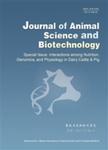Mixture models detect large effect QTL better than GBLUP and result in more accurate and persistent predictions
Mixture models detect large effect QTL better than GBLUP and result in more accurate and persistent predictions作者机构:Department of Animal ScienceIowa State University Hy-Line InternationalDallas Center
出 版 物:《Journal of Animal Science and Biotechnology》 (畜牧与生物技术杂志(英文版))
年 卷 期:2016年第7卷第4期
页 面:468-473页
核心收录:
学科分类:0710[理学-生物学] 07[理学] 08[工学] 0905[农学-畜牧学] 09[农学] 071007[理学-遗传学] 0836[工学-生物工程] 090501[农学-动物遗传育种与繁殖]
基 金:supported by Hy-Line Int. and the EW group
主 题:Bayesian methods Bias QTL
摘 要:Background: Accurate evaluation of SNP effects is important for genome wide association studies and for genomic prediction. The genetic architecture of quantitative traits differs widely, with some traits exhibiting few if any quantitative trait loci (QTL) with large effects, while other traits have one or several easily detectable QTL with large effects. Methods: Body weight in broilers and egg weight in layers are two examples of traits that have QTL of large effect A commonly used method for genome wide association studies is to fit a mixture model such as BayesB that assumes some known proportion of SNP effects are zero. In contrast, the most commonly used method for genomic prediction is known as GBLUP, which involves fitting an animal model to phenotypic data with the variance-covariance or genomic relationship matrix among the animals being determined by genome wide SNP genotypes. Genotypes at each SNP are typically weighted equally in determining the genomic relationship matrix for GBLUP. We used the equivalent marker effects model formulation of GBLUP for this study. We compare these two classes of models using egg weight data collected over 8 generations from 2,324 animals genotyped with a 42 K SNP ***: Using data from the first 7 generations, both BayesB and GBLUP found the largest QTL in a similar well-recognized QTL region, but this QTL was estimated to account for 24 % of genetic variation with BayesB and less than 1% with GBLUP. When predicting phenotypes in generation 8 BayesB accounted for 36 % of the phenotypic variation and GBLUP for 25 %. When using only data from any one generation, the same QTL was identified with BayesB in all but one generation but never with GBLUP. Predictions of phenotypes in generations 2 to 7 based on only 295 animals from generation 1 accounted for 10 % phenotypic variation with BayesB but only 6 % with GBLUP. Predicting phenotype using only the marker effects in the 1 Mb region that accounted for the largest e



